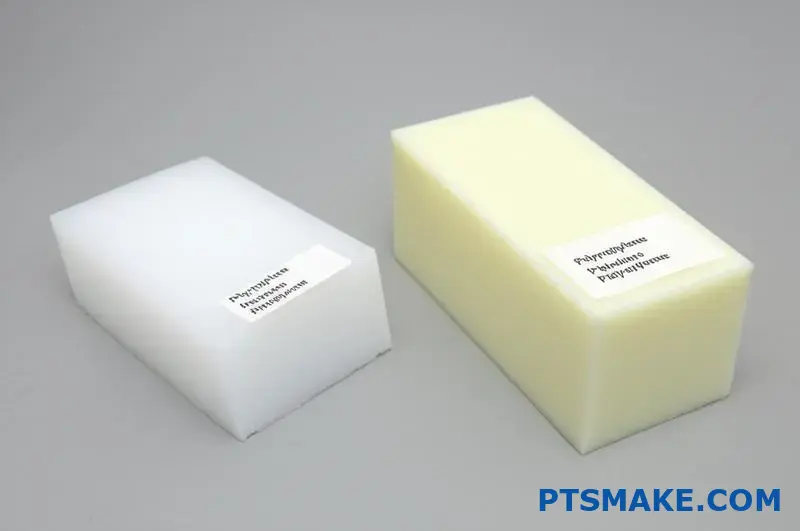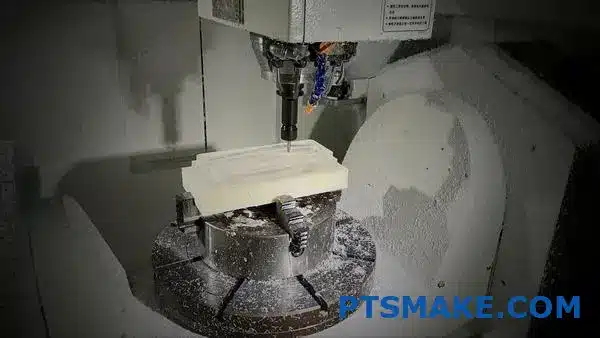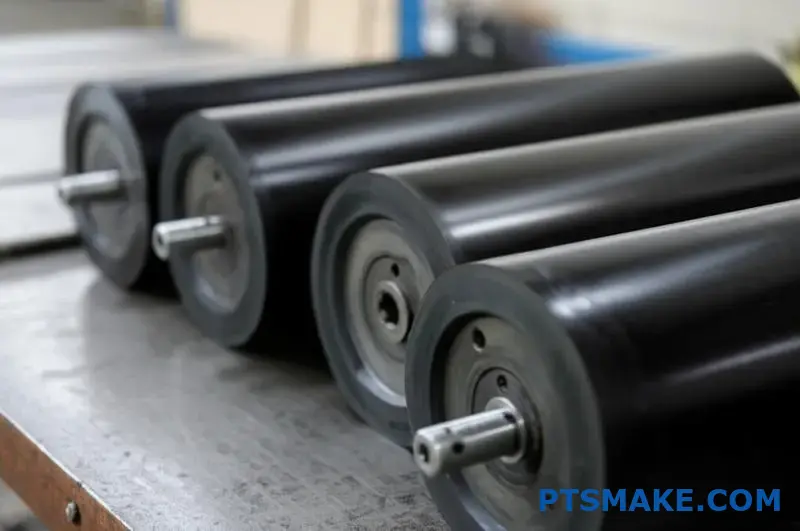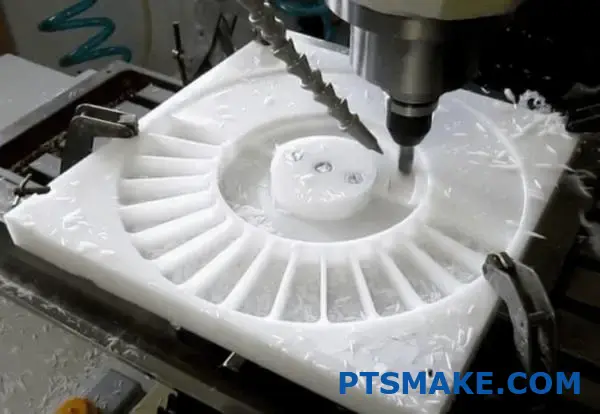Benefits of Aluminum vs Traditional Materials
Ever wondered if the box your speaker sits in matters as much as the speaker itself? The truth is, the enclosure material dramatically impacts sound quality. Let’s explore why aluminum is often a superior choice over traditional options like wood.
Aluminum speaker enclosures provide better sound clarity and performance consistency compared to wood. This is mainly due to aluminum’s superior rigidity, which reduces unwanted cabinet vibrations, and its excellent ability to dissipate heat generated by the speaker driver.
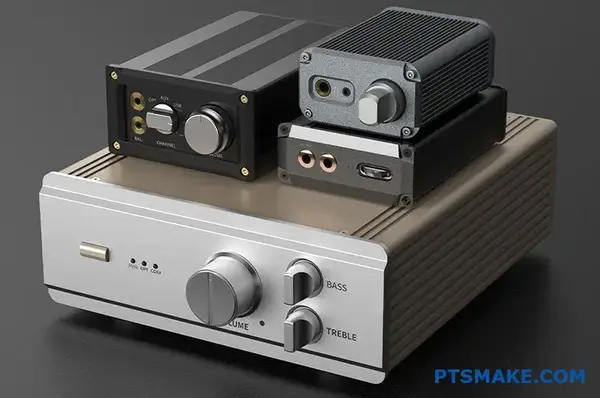
When designing high-fidelity audio equipment, the enclosure is far more than just a box. It plays a critical role in the overall acoustic performance. For years, wood, particularly MDF (Medium Density Fiberboard), has been the go-to material. It’s relatively inexpensive, easy to work with, and offers decent acoustic properties. However, traditional materials have inherent limitations that aluminum overcomes. At PTSMAKE, through our work in precision manufacturing, we’ve seen firsthand the tangible benefits of using aluminum for demanding applications, including high-performance speaker systems.
Superior Rigidity and Reduced Resonance
One of the most significant advantages of an aluminum speaker enclosure is its exceptional rigidity. Speaker drivers generate sound by moving back and forth rapidly, creating vibrations. Ideally, only the driver cone should move, projecting sound waves into the room. However, these vibrations also transfer energy to the enclosure itself.
The Problem with Less Rigid Materials
Materials like wood or plastic tend to vibrate along with the driver. This phenomenon, known as cabinet resonance, colors the sound in undesirable ways. The enclosure essentially becomes a secondary sound source, adding its own sonic signature, which can lead to muddy bass, blurred midrange, and overall loss of detail. Think of it like an unwanted echo chamber effect within the box itself.
Aluminum’s Acoustic Inertness
Aluminum, being much stiffer and denser than wood, resists these vibrations far more effectively. An aluminum speaker enclosure remains acoustically inert, meaning it doesn’t vibrate significantly or add its own coloration to the sound. This allows the speaker driver to perform exactly as intended, delivering a cleaner, more accurate, and detailed sound reproduction. The result is tighter bass, clearer vocals, and a more transparent listening experience. Our experience in CNC machining aluminum allows us to create enclosures with precise wall thicknesses and internal bracing, further enhancing this rigidity.
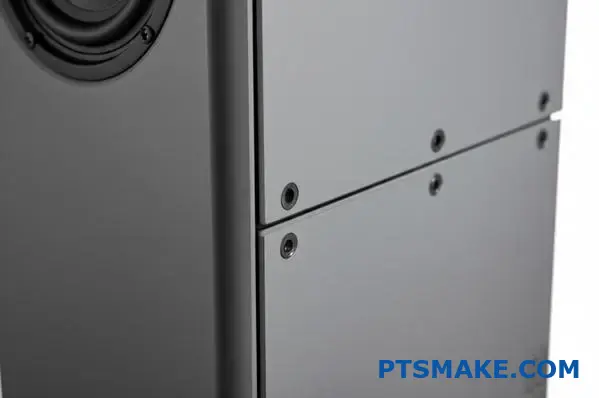
Excellent Heat Dissipation
Speaker drivers, especially powerful ones operating at high volumes for extended periods, generate a significant amount of heat. This heat buildup can negatively impact performance and even shorten the lifespan of the driver’s components, like the voice coil.
Heat Challenges in Traditional Enclosures
Wood and most plastics are poor conductors of heat; they act more like insulators. Heat generated by the driver gets trapped inside the enclosure, leading to thermal compression. This is where the driver’s parameters change due to elevated temperatures, affecting its sound output and consistency. Performance can degrade as the speaker gets hotter.
Aluminum as a Heatsink
Aluminum, conversely, is an excellent thermal conductor. It naturally draws heat away from the speaker driver components and dissipates it into the surrounding air. An aluminum speaker enclosure effectively acts as a large heatsink, keeping the driver operating within its optimal temperature range. This ensures consistent performance even during long listening sessions and contributes to the longevity of the speaker system. In past projects, we’ve observed significantly lower operating temperatures in aluminum designs compared to identical setups using wood, based on thermal imaging tests conducted with clients.
High Strength-to-Weight Ratio
Aluminum offers an impressive balance of strength and low weight, a property highly valued in engineering and product design.
Structural Integrity and Durability
Compared to wood or plastic, aluminum provides superior structural integrity. This allows for designs with thinner walls without sacrificing strength, potentially increasing the internal volume for better acoustic performance or enabling more compact designs. Aluminum is also highly durable, resistant to impact, moisture, and temperature fluctuations that can degrade wood over time. This makes aluminum speaker cabinets a robust and long-lasting investment. The inherent strength allows for precise machining, ensuring that parts fit together perfectly, which is crucial for eliminating air leaks and unwanted rattles in an enclosure. A good damping factor1 is easier to achieve with a rigid, well-sealed enclosure.
Lightweight Construction
Despite its strength, aluminum is significantly lighter than steel and often comparable in weight to denser woods, depending on the design and alloy used. This lower weight makes aluminum speaker enclosures easier to handle, ship, and install. For professional audio applications or larger home speakers, this reduction in weight can be a major practical advantage, simplifying mounting and reducing structural load requirements.
Here’s a simplified comparison highlighting key differences:
| Feature | Aluminum | Wood (MDF) | Plastic (ABS) |
|---|---|---|---|
| Rigidity | Very High | Moderate | Low to Moderate |
| Resonance | Very Low | Moderate | Moderate to High |
| Heat Dissipation | Excellent | Poor | Poor |
| Strength | High | Moderate | Moderate |
| Weight | Low | Moderate to High | Very Low |
| Durability | Excellent | Fair (Susceptible to moisture) | Good |
| Machinability | Good (Precision possible) | Excellent | Good (Molding typical) |

At PTSMAKE, we leverage advanced CNC machining techniques to craft aluminum speaker enclosures that meet exact specifications, ensuring optimal acoustic performance and structural integrity. The precision we can achieve with aluminum is often difficult to replicate consistently with wood, especially for complex internal geometries designed to manage airflow and break up standing waves.
Damping Solutions for Aluminum Cabinets
Aluminum offers amazing rigidity for speaker cabinets, but that very stiffness can create its own acoustic challenges. How do we counteract the potential ringing of metal to achieve truly pure sound? Let’s dive into the essential damping techniques.
Effective damping for an aluminum speaker enclosure relies on strategic methods like constrained layer damping, robust internal bracing, and specialized materials such as bituminous sheets. These solutions work together to absorb unwanted vibrations, ensuring clear and accurate audio reproduction.
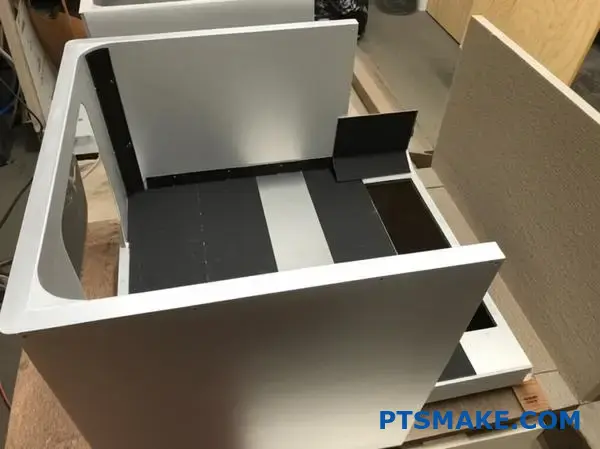
While aluminum’s stiffness is a major advantage over traditional materials like wood, preventing unwanted flex, it also has a tendency to "ring" at certain frequencies if not properly managed. This metallic resonance can add an unnatural coloration to the sound, detracting from the clarity we aim for. Addressing this requires specific damping strategies tailored to the properties of aluminum. At PTSMAKE, we often work with clients designing high-performance audio gear, and finding the right damping approach for an aluminum speaker enclosure is a frequent and critical discussion.
Understanding Aluminum Resonance
Unlike wood, which tends to damp vibrations internally to some extent, aluminum is highly resonant. Think of striking a tuning fork versus tapping on a block of wood. The aluminum panel, like the tuning fork, can sustain vibrations much longer. In a speaker cabinet, these sustained panel vibrations radiate sound energy that interferes with the direct sound from the driver, blurring details and potentially causing audible peaks or harshness at specific frequencies. The goal of damping isn’t to eliminate all vibration (which is impossible) but to quickly dissipate the vibrational energy before it negatively impacts the sound.
Constrained Layer Damping (CLD)
One of the most effective techniques for damping metal panels is Constrained Layer Damping, or CLD. This method involves creating a sandwich structure.
How CLD Works
Typically, a thin layer of a specialized viscoelastic2 material is bonded between the aluminum panel and a stiff constraining layer (often another thin sheet of metal or a rigid composite). When the main aluminum panel tries to vibrate (bend), it forces the viscoelastic layer to stretch and compress – a process called shear deformation. This deformation converts the mechanical energy of the vibration into a tiny amount of heat, effectively dissipating the vibrational energy and damping the resonance.
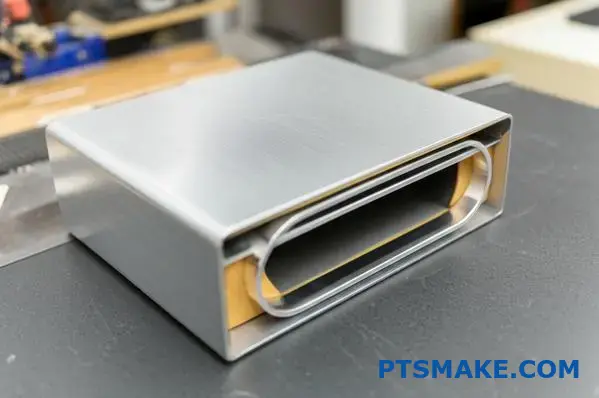
Material Choice and Application
The effectiveness of CLD depends heavily on the properties of the viscoelastic material and the stiffness of the constraining layer. Different materials are optimized for different temperature ranges and frequency bands. Correct application is also crucial; achieving a strong, continuous bond between all layers is essential for the shear mechanism to work efficiently. Surface preparation of the aluminum is key. In our precision manufacturing work at PTSMAKE, ensuring perfect adhesion for such processes is something we handle routinely.
Internal Bracing Strategies
Another vital approach is the use of internal bracing. Braces add significant stiffness to the cabinet panels and break large, resonant panels into smaller, less resonant sections.
Reducing Panel Flex
Strategically placed internal braces physically reinforce the enclosure walls, drastically reducing how much they can flex under pressure from the speaker driver’s rear wave. This minimizes a major source of cabinet-induced sound coloration.

Breaking Up Resonant Modes
Braces also alter the resonant frequencies of the panels. By dividing a large panel into smaller segments, the fundamental resonance frequency is pushed higher, often outside the most critical audio bands. Complex bracing patterns, like matrix or lattice structures, can be very effective. Designing and implementing these often involves CNC machining, allowing for intricate shapes that maximize stiffness while minimizing airflow obstruction inside the cabinet – a capability we frequently utilize at PTSMAKE for complex enclosure projects. The material for the brace itself can vary; aluminum braces maintain material consistency, while wood or MDF braces can sometimes add a different damping characteristic.
Specialized Surface Damping Materials
Beyond CLD and bracing, materials can be applied directly to the interior surfaces of the aluminum speaker enclosure to absorb vibrational energy.
Bituminous Damping Sheets
These are typically heavy, dense sheets made from asphalt-based compounds, often with an aluminum foil backing. They work primarily through mass loading and their inherent damping properties. When applied to a panel, they add mass, lowering the resonant frequency, and their soft, pliable nature helps absorb vibration energy, converting it into heat. They are particularly effective at lower frequencies but do add significant weight to the enclosure.
Other Damping Pads and Foams
Various other damping products exist, including specialized foams, rubber composites, and spray-on damping compounds. Each has different characteristics regarding effectiveness across the frequency spectrum, weight, ease of application, and cost. Some open-cell foams primarily absorb airborne sound waves inside the cabinet, while denser, closed-cell foams or rubber pads provide more direct panel damping. Careful selection based on the specific resonance issues and design constraints is important.
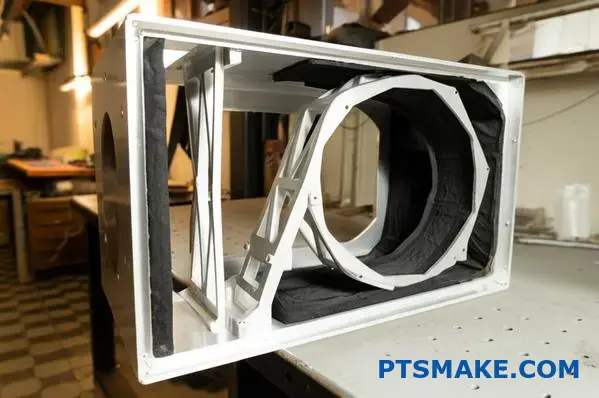
Combining Damping Techniques
Often, the best results in an aluminum speaker enclosure are achieved by combining multiple damping strategies. For instance, internal bracing might be used to stiffen large panels, while CLD or bituminous sheets are applied to address remaining resonance modes in specific areas.
Here’s a simplified comparison of common damping approaches:
| Damping Method | Primary Mechanism | Effectiveness | Weight Added | Cost Factor | Notes |
|---|---|---|---|---|---|
| CLD | Shear Deformation | High | Low-Moderate | Moderate | Requires precise application |
| Internal Bracing | Stiffness/Mode Breaking | High | Moderate | Moderate | Design complexity, potential airflow impact |
| Bituminous Sheets | Mass Loading/Absorption | Moderate-High (LF) | High | Low-Moderate | Best for lower frequencies |
| Damping Pads/Foams | Absorption/Mass Loading | Variable | Low-High | Variable | Wide range of materials and performance |
The optimal damping solution for any given aluminum speaker enclosure depends on the specific design, the driver characteristics, performance goals, and budget. Through careful analysis and application of these techniques, the inherent advantages of aluminum can be fully realized, resulting in a cabinet that is both structurally superior and acoustically neutral. Our experience at PTSMAKE confirms that a well-damped aluminum enclosure provides a fantastic foundation for high-fidelity sound reproduction.
Design Considerations for CNC Manufacturing
Bringing an aluminum speaker enclosure concept to life requires more than just choosing the right material. How you design it specifically for CNC manufacturing is crucial. Let’s explore the key design choices that unlock the full potential of CNC-machined aluminum for superior audio performance.
Designing aluminum speaker enclosures for CNC manufacturing involves optimizing wall thickness for rigidity and machinability, incorporating effective internal supports, and specifying precise tolerances. These factors leverage CNC’s capabilities to create complex, high-performance, and acoustically sound cabinets.

Transitioning from traditional materials like wood to aluminum opens up incredible possibilities for speaker enclosure design, but it also introduces new considerations, especially when Computer Numerical Control (CNC) machining is the manufacturing method. At PTSMAKE, we frequently collaborate with clients on these designs, guiding them through the nuances of creating parts optimized for precision manufacturing. It’s not just about the final shape; it’s about designing for the process to achieve the best results efficiently. Getting the design right upfront saves time, reduces cost, and ultimately leads to a better-performing aluminum speaker enclosure.
Optimizing Wall Thickness
One of the first decisions is how thick the aluminum walls should be. While aluminum’s inherent stiffness allows for thinner walls compared to MDF, there’s a balance to strike.
Finding the Sweet Spot
We generally recommend a minimum wall thickness of around 3/8" (approximately 9.5mm) for many aluminum speaker enclosures. Why? Thinner walls, while lighter, can be more prone to resonance (ringing) and potentially more challenging to machine perfectly flat over large areas without specialized fixtures. Thicker walls significantly increase rigidity and are easier to machine flat, but they also add weight and material cost. A thickness around 3/8" often provides a good starting point, balancing rigidity, machinability, weight, and cost. However, the optimal thickness truly depends on the enclosure size, the driver used, and the specific performance goals.
CNC Machining Flexibility
A key advantage of CNC machining is its ability to handle varying wall thicknesses within the same part. You could design thicker sections where maximum rigidity is needed (like around the driver cutout) and slightly thinner sections elsewhere to save weight, something difficult or impossible with standard sheet materials or molding. This allows for highly optimized designs that aren’t restricted to uniform thickness.
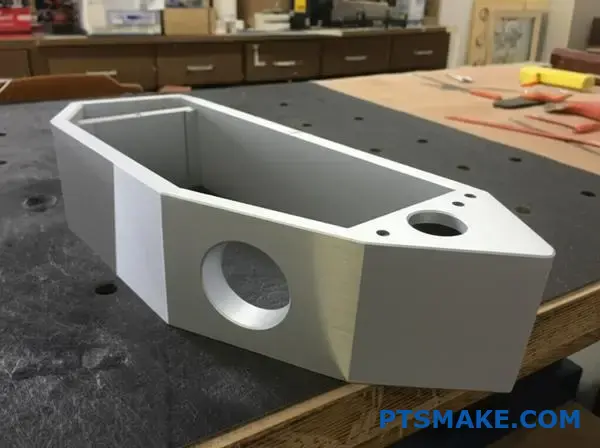
Designing Internal Support Structures
Just like in wooden cabinets, internal bracing is vital in an aluminum speaker enclosure to enhance stiffness and control resonance. CNC machining takes bracing possibilities to a whole new level.
Integrated Bracing
Instead of just adding separate brace pieces, CNC allows us to machine intricate internal support structures directly into the enclosure walls or as interlocking components. Think complex rib patterns, lattice structures, or precisely shaped supports designed using Finite Element Analysis (FEA) to target specific resonant modes. This integration creates an incredibly strong and acoustically inert structure.
Advantages Over Traditional Methods
Creating such complex bracing in wood is often labor-intensive and less precise. With CNC aluminum, these features become part of the primary machining process. This ensures perfect fitment, maximizes internal volume compared to bulky traditional braces, and allows for designs that strategically manage airflow and break up standing waves within the enclosure. In past projects at PTSMAKE, we’ve machined enclosures from solid aluminum blocks where the bracing was integral to the part, resulting in exceptional rigidity.
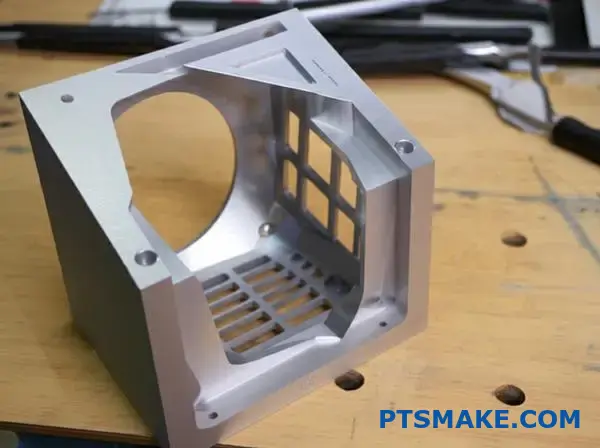
The Critical Role of Precise Tolerances
Tolerances define the allowable variation in dimensions. For speaker enclosures, especially high-performance ones, tight tolerances are non-negotiable, and CNC machining is the key to achieving them in aluminum.
Why Tolerances Matter
- Airtight Seals: Small gaps between panels or around the driver can cause air leaks, leading to whistles, loss of bass efficiency, and unpredictable performance.
- Driver Fitment: The driver must fit snugly and be perfectly aligned. Incorrect cutout dimensions or uneven mounting surfaces compromise the seal and can stress the driver frame.
- Panel Alignment: Ensuring panels fit together perfectly prevents rattles and ensures structural integrity.
CNC machining routinely achieves tolerances measured in thousandths of an inch (or hundredths of a millimeter), far tighter and more consistent than typically possible with manual woodworking. Defining these tolerances correctly on engineering drawings, using concepts like a proper Datum3, is crucial for the manufacturer.
Enabling Complex Geometries
Beyond basic boxes, CNC machining excels at creating complex shapes that can enhance both acoustics and aesthetics. Think curved baffles to reduce diffraction, precisely angled internal surfaces to manage reflections, integrated waveguides, or complex port shapes (like flared or folded designs) for optimized airflow and reduced turbulence. These features, often impractical or impossible with other methods, are readily achievable with multi-axis CNC machines, allowing designers true freedom.
Perfecting Driver Mounting Surfaces
The area where the speaker driver mounts is perhaps the most critical interface. CNC ensures this surface is perfectly flat, which is essential for an airtight seal against the driver gasket. It allows for precise machining of:
- Cutout Diameter: Ensuring the driver fits exactly right.
- Countersinks/Counterbores: Allowing drivers to be flush-mounted for a clean look and better acoustic integration.
- Mounting Holes: Perfectly positioned and tapped for secure driver attachment.
This level of precision directly translates to better acoustic performance by eliminating leaks and ensuring the driver operates as intended.

Here’s a quick summary of key CNC design considerations for aluminum speaker enclosures:
| Design Feature | CNC Advantage | Design Tip | Impact on Performance |
|---|---|---|---|
| Wall Thickness | Precise control, variable thickness | Start around 3/8" (9.5mm), optimize via FEA | Rigidity, resonance control, weight |
| Internal Bracing | Complex, integrated structures possible | Use FEA to design efficient patterns | Increased stiffness, reduced resonance |
| Tolerances | High precision, consistency | Specify critical tolerances clearly | Airtight seals, proper fit, no rattles |
| Geometry | Enables curves, complex shapes | Leverage for acoustic/aesthetic benefits | Reduced diffraction, better airflow |
| Driver Mounting | Flat surfaces, precise features | Ensure flatness, correct diameters/depths | Optimal seal, correct driver alignment |
By considering these factors during the design phase, you leverage the strengths of CNC machining to create an aluminum speaker enclosure that is not only manufacturable but also performs at the highest level. At PTSMAKE, our expertise lies in turning these complex designs into reality, ensuring every detail aligns with your vision for precision and quality, from prototype to production.
Weatherproofing Options for Marine Applications
Thinking about bringing your audio outdoors, especially near the water? Boats, poolside patios, and coastal homes demand speaker enclosures that can withstand sun, salt, and spray. How can we ensure an aluminum speaker enclosure survives these harsh marine conditions?
For marine applications, an aluminum speaker enclosure needs robust weatherproofing. While naturally corrosion-resistant, treatments like anodizing or powder coating, combined with marine-grade hardware, are essential to prevent damage from saltwater and humidity, ensuring long-term performance and appearance.
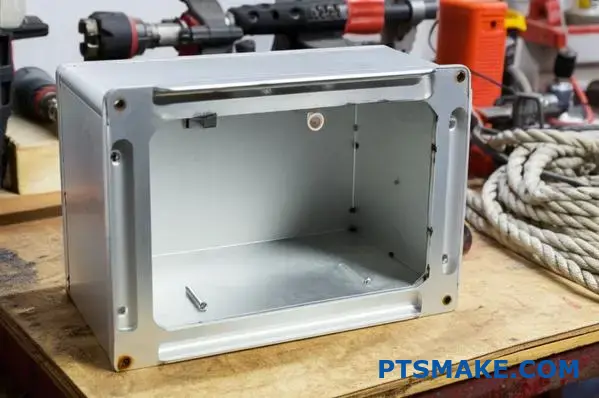
Aluminum is often praised for its natural resistance to corrosion. It forms a thin, tough layer of aluminum oxide on its surface almost instantly when exposed to air, which protects the metal underneath. However, marine environments present a much tougher challenge than typical indoor or even standard outdoor settings. Constant exposure to saltwater spray, high humidity, and UV radiation can overwhelm this natural protection over time. Salt, in particular, is aggressive and can lead to pitting corrosion or other forms of degradation if the aluminum isn’t properly prepared. At PTSMAKE, we’ve worked on projects destined for demanding environments, and selecting the right protective finish is a critical step we always address with our clients. An untreated or poorly treated aluminum speaker enclosure simply won’t last long when battling the elements at sea or coast side.
Anodizing: Enhancing Natural Protection
Anodizing is an electrochemical process that significantly thickens and toughens the natural oxide layer on aluminum. It creates a very hard, durable surface that is integral to the metal itself, not just a coating applied on top.
Why Anodizing Works for Marine Use
For marine applications, Type III anodizing, often called hardcoat anodizing, is usually the preferred choice. It produces a much thicker and denser oxide layer compared to standard Type II anodizing, offering superior resistance to abrasion, wear, and corrosion. This toughness is invaluable when the enclosure might be subject to bumps, scrapes, or constant exposure to salt spray.
The Importance of Sealing
After the anodizing process creates the porous oxide layer, it must be sealed. This step closes the microscopic pores in the layer, dramatically improving corrosion resistance by preventing contaminants like saltwater from penetrating down to the base aluminum. Various sealing methods exist, including hot water, mid-temperature seals, and cold seals, each with specific benefits. Proper sealing is non-negotiable for any anodized aluminum speaker enclosure intended for marine use. While anodizing offers some color options, the primary benefit in this context is its protective quality.
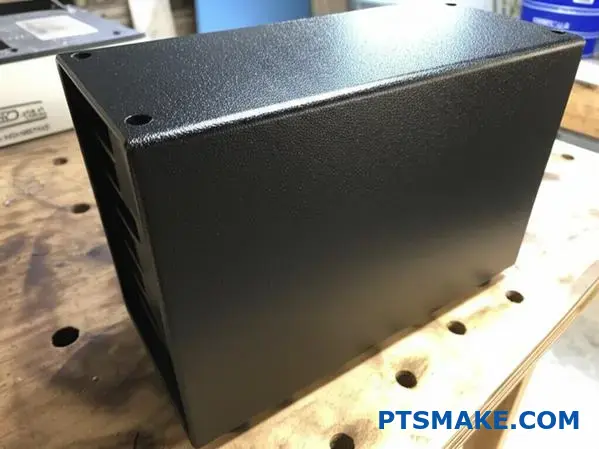
Powder Coating: A Resilient Barrier
Powder coating offers a different approach. Instead of modifying the aluminum surface itself, it applies a protective layer of polymer powder electrostatically, which is then cured under heat to form a hard, durable "skin."
Benefits of Powder Coating in Harsh Conditions
A properly applied powder coat provides excellent protection against moisture, chemicals, salt spray, and UV light. The cured finish is typically much thicker than liquid paint, making it resistant to chipping, scratching, and fading. Marine-grade powder coating formulations are specifically designed to withstand prolonged exposure to saltwater and intense sunlight.
Pre-treatment is Key
The longevity of a powder coat heavily depends on the surface preparation of the aluminum beneath it. Simply applying powder to bare aluminum isn’t enough, especially for marine environments. A thorough cleaning followed by an etching process or, ideally, a chemical conversion coating (like a chromate or non-chromate treatment) is essential. This pre-treatment creates a surface profile that promotes strong adhesion between the aluminum and the powder coat, preventing moisture from creeping underneath and causing blistering or failure. We emphasize this critical step in our manufacturing processes at PTSMAKE.
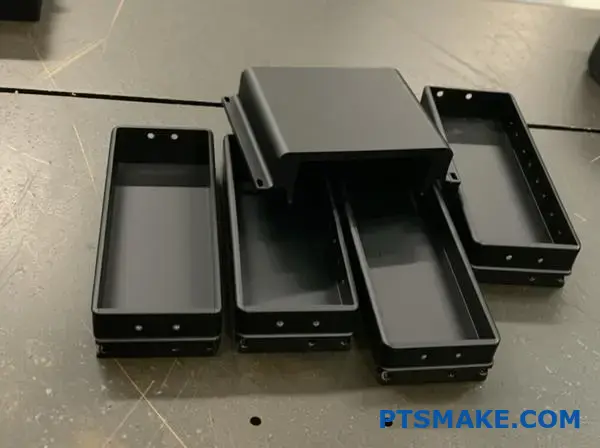
Choosing Between Anodizing and Powder Coating
Both hardcoat anodizing and marine-grade powder coating can provide excellent protection for an aluminum speaker enclosure in marine environments. The choice often depends on specific requirements:
| Feature | Hardcoat Anodizing (Type III) | Marine-Grade Powder Coating |
|---|---|---|
| Corrosion Resist. | Excellent (when sealed) | Excellent (when pre-treated) |
| Abrasion Resist. | Superior | Very Good |
| Appearance | Metallic look, limited colors | Wide range of colors/textures |
| Coating Type | Integral to metal | Applied layer (polymer) |
| Repairability | Difficult to touch up locally | Can sometimes be touched up |
| Electrical Cond. | Typically Insulating | Insulating |
In some high-demand applications, combining methods is even possible, such as powder coating over an anodized surface for maximum protection, though this adds complexity and cost.
Don’t Forget the Hardware: Marine-Grade is a Must
The enclosure finish is only part of the battle. Using the wrong screws, bolts, or fittings can lead to rapid failure due to galvanic corrosion4. This occurs when dissimilar metals are in contact in the presence of an electrolyte (like saltwater). The less noble metal (often aluminum or standard steel fasteners) corrodes preferentially.
Stainless Steel Solutions
For marine applications involving aluminum, Grade 316 stainless steel fasteners are highly recommended. This grade contains molybdenum, which significantly increases its resistance to chloride corrosion (like from saltwater) compared to the more common 18-8 (Grade 304) stainless steel. Using 316 stainless for all screws, bolts, handles, and mounting hardware is crucial for preventing unsightly rust stains and, more importantly, avoiding structural failure caused by corroded fasteners.
Isolation Techniques
If using dissimilar metals is unavoidable, employing isolating washers or gaskets made from non-conductive materials like nylon or neoprene between the fastener and the aluminum surface can help break the electrical circuit and mitigate galvanic corrosion.
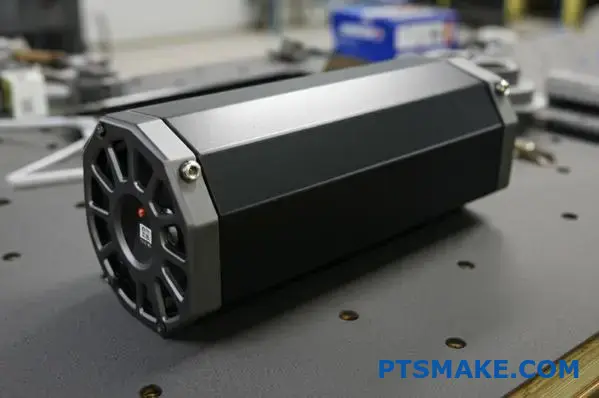
Sealing the Deal: Gaskets and Ingress Protection
Finally, ensuring the enclosure is properly sealed against water intrusion is paramount. This involves using high-quality, weather-resistant gaskets around speaker drivers, access panels, input/output connectors, and any other openings. Materials like silicone, EPDM, or neoprene are often good choices due to their durability and resistance to UV and saltwater. Look for enclosures or designs targeting specific Ingress Protection (IP) ratings, such as IP65 or higher, which indicate resistance to dust and water jets, offering assurance of their suitability for exposed marine environments. Based on our tests and client feedback, proper gasketing is as vital as the surface finish itself for long-term reliability.
By carefully selecting the right surface treatment (anodizing or powder coating), using appropriate marine-grade hardware, and ensuring robust sealing, an aluminum speaker enclosure can be confidently deployed in even the most challenging marine applications, providing years of reliable audio enjoyment.
Acoustic Performance Optimization
So, you’ve chosen aluminum for its stiffness, but does that automatically guarantee perfect sound? Not quite. Optimizing the inside of the box is just as critical as the material itself. Let’s unlock that next level of audio clarity.
Optimizing an aluminum speaker enclosure involves precise internal volume calculation, meticulous port tuning (if used), and tailored crossover design. These steps harness aluminum’s rigidity for exceptionally clear bass and detailed sound reproduction.
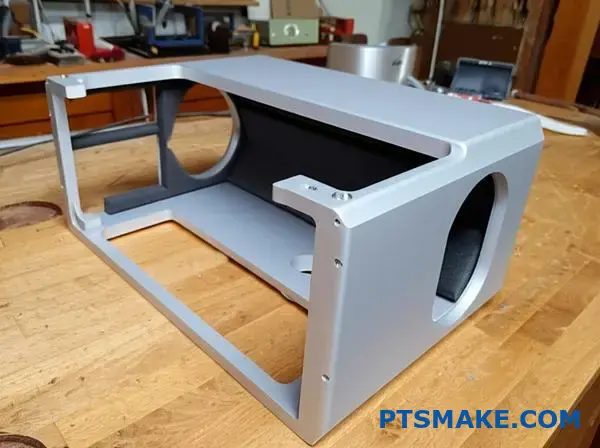
Choosing an aluminum speaker enclosure is a fantastic start for high-fidelity sound, primarily due to its rigidity compared to wood. This stiffness significantly reduces unwanted cabinet vibrations, preventing the enclosure itself from muddying the sound. However, simply using aluminum isn’t the end of the story. To truly leverage its potential and achieve exceptional audio performance, careful acoustic optimization within the enclosure is essential. At PTSMAKE, we collaborate closely with clients during the design phase, focusing on these internal details because we know they make a tangible difference in the final sound quality. It’s about making the aluminum work for the sound, not just containing it.
Strategic Internal Volume Calculation
The internal air volume of a speaker enclosure is a fundamental parameter that directly influences its low-frequency performance. Getting it right is crucial, especially with sealed or ported designs.
Why Volume Matters
The interaction between the speaker driver and the air volume inside the cabinet behaves like a spring system. This relationship is described by the driver’s Thiele/Small parameters. The internal volume dictates the "stiffness" of this air spring, significantly affecting the speaker’s bass extension (how low it can play), its efficiency, and the overall character of the bass response (e.g., tight and controlled vs. deep but potentially looser). Calculating the target volume accurately based on the specific driver is step one for predictable performance.
Aluminum’s Role in Volume Accuracy
Because aluminum panels are very rigid and don’t flex easily under the pressure changes created by the driver, the calculated internal volume remains stable during operation. Less rigid materials can effectively change their perceived volume as the walls flex, altering the tuning. Furthermore, CNC machining, which we specialize in at PTSMAKE, allows us to create enclosures with highly precise internal dimensions, ensuring the final product matches the calculated target volume very accurately. This precision is harder to achieve consistently with manual woodworking.
Balancing Volume and Size
Often, the ideal acoustic volume might conflict with desired external dimensions or aesthetic goals. CNC machining provides flexibility here. We can create non-cuboid shapes, incorporate internal contours, or use slightly thinner walls (where appropriate and structurally sound) to maximize internal volume within a given external footprint. This optimization helps achieve the acoustic goals without unnecessary bulk.
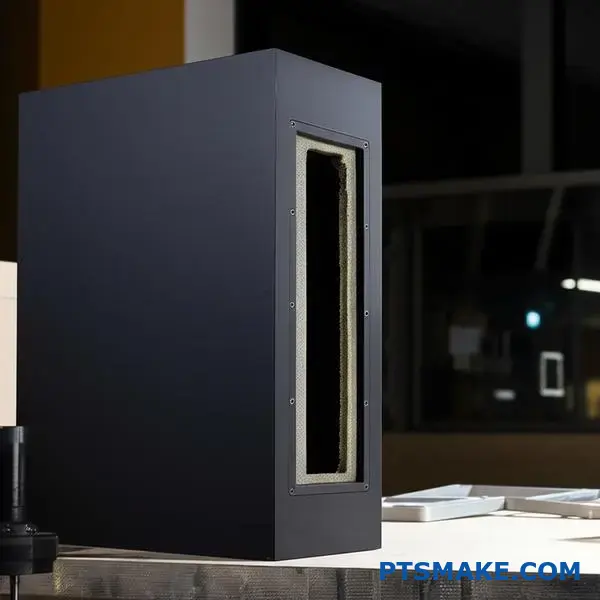
Precision Port Tuning (for Vented Designs)
For vented or ported speaker enclosures (also known as bass-reflex designs), a tube or opening (the port) is added to enhance low-frequency output around a specific frequency.
The Science of Ports
A ported enclosure acts like a Helmholtz resonator. The air inside the box acts as a spring, and the air mass within the port acts as a weight. This system resonates at a specific frequency, determined by the enclosure volume and the port’s dimensions (length and cross-sectional area). At this tuning frequency, the sound radiating from the port reinforces the driver’s output, extending the bass response and often increasing efficiency compared to a sealed box of the same size.
Aluminum & CNC Advantages for Ports
The effectiveness of a port depends heavily on smooth airflow. Abrupt edges or rough surfaces inside the port can cause air turbulence, leading to audible "chuffing" or whistling noises, especially at higher volumes. CNC machining allows us to create ports with extreme precision and smooth internal finishes. More importantly, it enables the creation of complex port shapes:
- Flares: Smooth, rounded transitions at the port entrance and exit significantly reduce turbulence and port noise. Machining precise, consistent flares in aluminum is straightforward with CNC.
- Slot Ports: Sometimes, a long, thin slot is preferred over a round tube for aesthetic or packaging reasons. CNC can machine these with high accuracy.
- Folded Ports: To achieve long port lengths (for low tuning frequencies) in compact boxes, the port can be "folded" internally. CNC machining makes realizing these complex internal geometries practical.
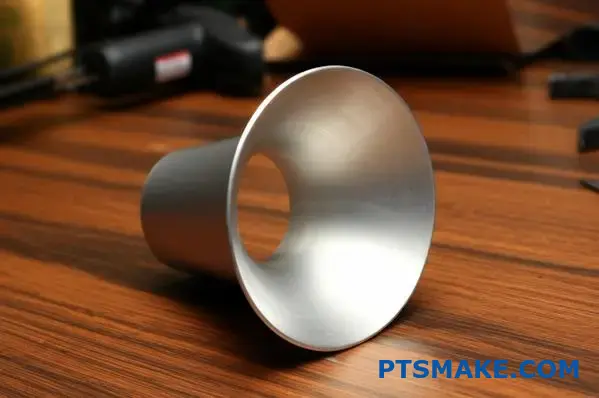
Tuning Accuracy
Because aluminum is dimensionally stable and CNC machining is highly precise, the port dimensions achieved in manufacturing will closely match the design intent. This ensures the enclosure is tuned exactly to the target frequency calculated during the design phase, leading to predictable and optimal bass performance. This level of accuracy can be more challenging with wood due to its variability and susceptibility to swelling/shrinking.
Specialized Crossover Design
The crossover network in a multi-driver speaker (e.g., one with a woofer and a tweeter) acts like a traffic cop for audio frequencies, directing lows to the woofer and highs to the tweeter.
Crossover Function
The goal is a seamless transition between drivers so the speaker sounds like a single coherent source. The crossover uses components like capacitors, inductors, and resistors to filter the signal appropriately for each driver.
Adapting to Aluminum’s Signature
Because a well-designed aluminum speaker enclosure has significantly less resonance and coloration than a typical wooden box, the raw acoustic output of the drivers mounted within it is often cleaner and more revealing of the driver’s true behavior. This can impact crossover design. The designer might find that:
- Different Filter Slopes: The rate at which frequencies are rolled off might need adjustment because the enclosure isn’t adding its own resonant peaks or dips that the crossover might otherwise need to compensate for.
- Component Value Changes: Resistor, capacitor, or inductor values might need tweaking to achieve the target frequency response and phase alignment between drivers.
It’s crucial to measure the drivers’ responses in the actual aluminum enclosure to design the crossover accurately. Basing it on measurements from a different (e.g., wooden) test box can lead to suboptimal results.
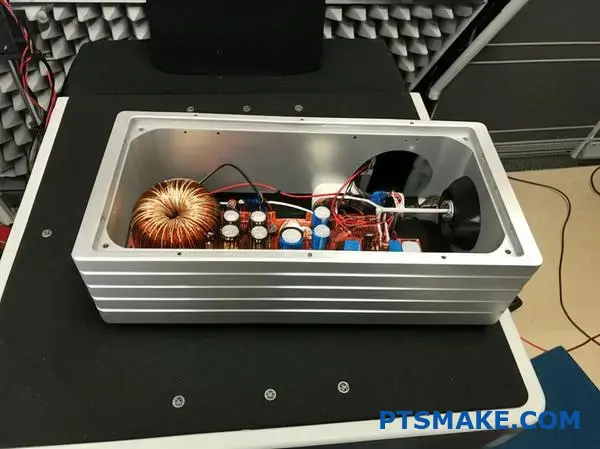
Leveraging Rigidity for Simplicity?
In some cases, the cleaner output afforded by the rigid aluminum enclosure might even allow for slightly simpler crossover designs, as less equalization or compensation for cabinet-induced anomalies is needed. The crossover can focus more purely on integrating the drivers themselves.
Impact on Bass Response and Transients
Ultimately, these optimization steps, combined with aluminum’s inherent properties, lead to tangible improvements in sound quality.
Cleaner, Tighter Bass
Reduced cabinet vibration means the enclosure contributes far less unwanted sound, especially at low frequencies. The bass you hear is generated primarily by the driver’s cone moving air, not by the box walls vibrating sympathetically. This results in bass that is tighter, more defined, and less "boomy" or muddy. The precise volume and port tuning further ensure the bass extends deeply and accurately according to the design goals.
Improved Transient Response5
The extreme rigidity of the aluminum speaker enclosure provides a stable platform for the driver. This allows the driver’s cone to react instantly to the audio signal, starting and stopping its motion very quickly without the enclosure flexing or storing and releasing energy seconds later. This results in sharper attacks (like the crack of a snare drum or the pluck of a guitar string) and a clearer sense of rhythm and timing.
Here’s how these optimization techniques specifically address the characteristics of an aluminum speaker enclosure:
| Technique | Aluminum Property Addressed | Acoustic Goal Achieved | PTSMAKE CNC Advantage |
|---|---|---|---|
| Volume Calculation | High Rigidity | Predictable, accurate bass tuning | Precise internal dimension control |
| Port Tuning | High Rigidity, Machinable | Extended bass, low port noise | Smooth surfaces, complex flare shapes |
| Crossover Design | Low Resonance | Seamless driver integration, transparency | Enables use of data from rigid cabinet |
| Overall Design | High Rigidity | Clean bass, excellent transient response | Precise execution of optimized designs |
By focusing on internal volume, port design (if applicable), and crossover tuning specifically for the unique properties of aluminum, we can move beyond just a "metal box" and create a truly high-performance aluminum speaker enclosure. It’s this attention to detail, enabled by precision manufacturing, that unlocks the full potential of the material for stunning sound reproduction.
Cost Analysis and ROI for Manufacturing
Investing in aluminum speaker enclosures often means a higher initial price tag. But does that upfront cost tell the whole story? Let’s dig into the financials, comparing the initial spend with the long-term benefits to see where the true value lies.
Choosing an aluminum speaker enclosure involves higher initial material and tooling expenses compared to wood or plastic. However, factors like enhanced durability, reduced assembly needs due to precision, and higher market appeal contribute to a potentially strong return on investment over time.
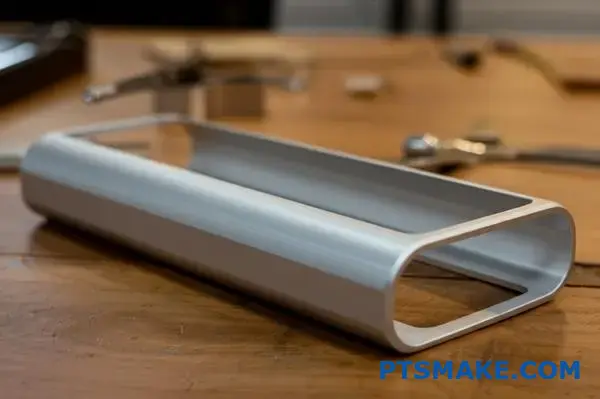
When clients approach us at PTSMAKE about manufacturing an aluminum speaker enclosure, one of the first topics is inevitably the cost. It’s true, the initial investment for aluminum, especially when involving CNC machining, can be higher than using materials like MDF or injection-molded plastic. But focusing solely on the upfront price misses the bigger picture: the total cost of ownership and the potential return on that investment (ROI). Let’s break down the different cost factors and value propositions.
Breaking Down the Initial Investment
The initial outlay for producing an aluminum speaker enclosure primarily involves tooling and material costs. These can vary significantly depending on the manufacturing method and complexity.
Tooling Costs: CNC vs. Molds
- CNC Machining: For prototypes or lower volume production runs, CNC machining often has lower initial tooling costs compared to injection molding. The "tooling" mainly consists of programming time and potentially specialized fixtures to hold the aluminum block or extrusion during machining. This cost is spread over fewer parts initially, making the per-part cost higher in low volumes but more accessible to start.
- Injection Molding/Die Casting (for Aluminum): If aiming for very high volumes, die casting aluminum might be considered. However, the initial cost for creating the hardened steel molds required for die casting is substantial. This makes sense only when producing tens or hundreds of thousands of units where the mold cost can be amortized effectively. For most high-fidelity speaker applications where volumes are moderate, CNC machining remains the primary method. At PTSMAKE, we specialize in CNC, offering flexibility from prototype to production runs without the massive upfront mold investment of die casting.
Material Costs: Aluminum vs. Alternatives
Aluminum as a raw material is generally more expensive per kilogram than MDF or standard ABS plastic. The specific alloy chosen (e.g., 6061 vs. 5052) will also influence the cost slightly. This higher material cost directly impacts the per-unit price of the enclosure. However, aluminum’s strength means you might sometimes use less material (thinner walls where appropriate) compared to achieving similar rigidity with other materials, though this needs careful engineering.
Manufacturing Efficiencies and Savings
While initial costs are higher, precision manufacturing methods like CNC machining, which we excel at within PTSMAKE, introduce efficiencies that offset some expenses down the line.
Reduced Assembly Time via Precision
CNC machining delivers parts with extremely tight tolerances. When enclosure panels, mounting points, and bracing features are machined precisely, they fit together perfectly. This significantly reduces the time and labor required during the final assembly stage. There’s less need for manual adjustments, filling gaps, or forcing fits, which are common issues with less precise manufacturing methods. Based on projects we’ve handled, this assembly efficiency can lead to noticeable labor cost savings, especially as production volume increases.
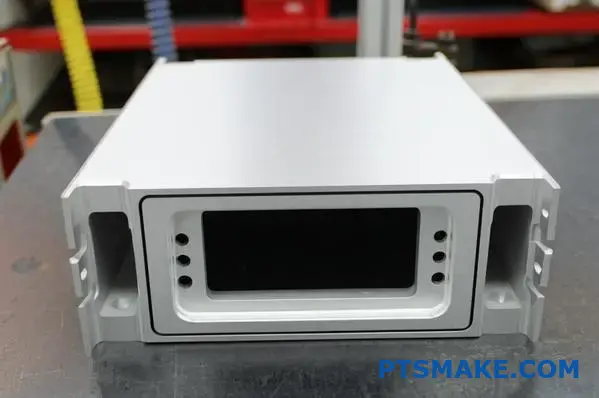
Lowering Waste with CNC Machining
Modern CNC machining processes, coupled with smart software, optimize tool paths and material usage. While machining does produce chips (swarf), the process is highly controlled, leading to less unpredictable waste compared to manual cutting or shaping. The aluminum chips are also highly recyclable, adding a sustainability aspect and potential scrap value recovery.
Long-Term Value and Return on Investment
This is where the aluminum speaker enclosure truly starts to shine, justifying the initial investment for many applications.
Durability and Lifespan Advantage
Aluminum doesn’t warp, crack, or swell due to humidity like wood (especially MDF) can. It’s resistant to impacts and temperature fluctuations. An aluminum speaker enclosure is built to last significantly longer than its traditional counterparts, retaining its structural and acoustic integrity for years, even decades. This longevity translates directly to value – fewer replacements, consistent performance, and enduring customer satisfaction.
Premium Aesthetics and Market Positioning
Aluminum has an inherent premium feel and appearance. Finishes like brushing, anodizing, or powder coating further enhance this aesthetic appeal. Products housed in aluminum often command a higher price in the market because consumers associate the material with quality, durability, and superior performance. This allows brands to position their speakers in a higher tier, potentially achieving better profit margins that help recoup the initial investment faster.
Calculating the Total Cost of Ownership
To make a truly informed decision, it’s helpful to look beyond the purchase price and consider the Total Cost of Ownership (TCO)6. This includes the initial cost, but also factors in expected lifespan, maintenance needs (minimal for aluminum), potential repair costs (less likely due to durability), and the end value (resale or perceived brand value). When viewed through the TCO lens, the higher initial cost of aluminum often proves more economical over the product’s lifecycle compared to cheaper materials that might need earlier replacement or fail to deliver a premium experience.
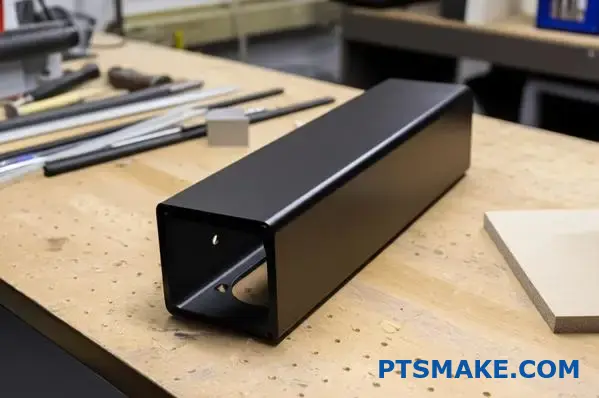
Comparing Costs: A Relative Perspective
Here’s a simplified table comparing key factors on a relative scale (Low, Medium, High):
| Factor | Aluminum (CNC Machined) | Wood (MDF) | Plastic (Injection Molded) |
|---|---|---|---|
| Initial Material Cost | High | Low | Low-Medium |
| Initial Tooling (Low Vol) | Medium (CNC) | Low | Very High (Mold) |
| Initial Tooling (High Vol) | High (CNC/Die Cast) | Low | High (Mold Amortized) |
| Assembly Labor | Low (High Precision) | Medium | Medium |
| Durability/Lifespan | Very High | Medium | Medium-High |
| Premium Feel/Value | High | Medium | Low-Medium |
| Potential ROI | High (Long-Term) | Medium | Medium (High Volume) |
Ultimately, the decision hinges on balancing budget, performance goals, desired product lifespan, and market positioning. While the sticker price of an aluminum speaker enclosure is higher, its manufacturing precision, exceptional durability, and premium appeal often result in a superior long-term value proposition and a strong return on investment. At PTSMAKE, we believe in transparency and help our clients weigh these factors to make the best choice for their specific needs, ensuring they understand both the costs and the significant benefits aluminum offers.
Integration with Existing Audio Systems
Got a complex audio setup already? Wondering how a new aluminum speaker enclosure will slot in without hassle or noise? The material and precision of that enclosure matter more than you might think for seamless integration. Let’s explore why.
Aluminum speaker enclosures integrate smoothly into existing audio systems thanks to their versatile mounting options and superior electromagnetic shielding. Their precision construction ensures consistent performance and reliable connections, especially crucial in complex multi-component setups.
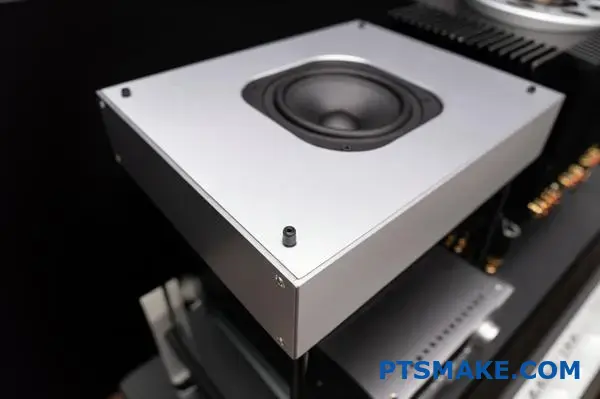
Bringing a new speaker into an established audio ecosystem, whether it’s a sophisticated home theater, a recording studio rack, or a multi-room setup, involves more than just plugging in cables. Physical placement, electrical compatibility, and avoiding interference are key challenges. The enclosure itself plays a critical role here. While wood and plastic have their place, the properties of an aluminum speaker enclosure, especially one crafted with precision manufacturing techniques like those we use at PTSMAKE, offer distinct advantages for seamless integration.
Versatile Mounting and Placement
Getting the speaker positioned correctly is often the first integration hurdle. You need it securely placed for optimal sound staging and safety, potentially on walls, ceilings, or custom stands.
Precision Enables Flexibility
This is where the strength and machinability of aluminum shine. Using CNC machining, we can incorporate highly accurate mounting solutions directly into the aluminum speaker enclosure design:
- Precisely Located Mounting Holes: Drilled and tapped holes matching standard brackets (like VESA mounts for some applications) or custom mounting hardware can be machined with tolerances measured in microns. This guarantees perfect alignment.
- Integrated Threaded Inserts: Unlike screwing directly into wood (which can strip) or plastic (which can crack), precisely machined threads in aluminum provide robust and reliable attachment points for bolts. We can also seamlessly integrate steel threaded inserts for even greater strength if needed.
- Custom Bracket Integration: The rigidity of aluminum allows for the secure attachment of complex or heavy-duty mounting brackets, essential for larger speakers or unconventional placements. The enclosure itself becomes a stable part of the mounting system.
In our experience at PTSMAKE, clients appreciate the confidence that comes with CNC-machined mounting points. There’s no guesswork; the speaker fits the intended mount perfectly every time, simplifying installation considerably compared to materials with less dimensional precision.
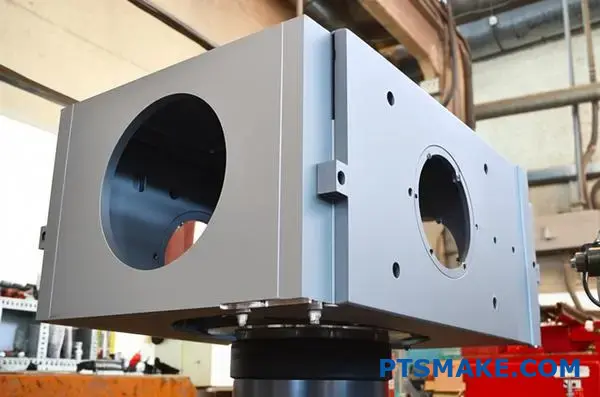
Superior Electromagnetic Shielding (EMI/RFI Protection)
Modern audio systems are often dense with electronics: amplifiers, DACs, streamers, power supplies, wireless devices (Wi-Fi, Bluetooth). All these can generate electromagnetic interference (EMI) or radio frequency interference (RFI), which can manifest as hum, buzz, or digital noise in your audio signal.
Aluminum as a Shield
Aluminum is an excellent electrical conductor. This property allows an aluminum speaker enclosure to act as a Faraday cage effect7, effectively blocking external electromagnetic fields from reaching sensitive internal components like the speaker’s crossover network. Simultaneously, it helps contain any electromagnetic fields generated by the speaker driver itself, preventing the speaker from interfering with other nearby sensitive equipment.
Why It Matters in Complex Systems
In a simple setup, interference might be less of an issue. But in a complex system with multiple components packed closely together, the cumulative effect of EMI/RFI can degrade performance significantly. Wood and plastic enclosures offer virtually no inherent shielding capabilities, leaving internal components vulnerable and potentially allowing the speaker to pollute the electrical environment for other gear. An aluminum speaker enclosure provides a built-in layer of protection, contributing to a cleaner signal path throughout the system.
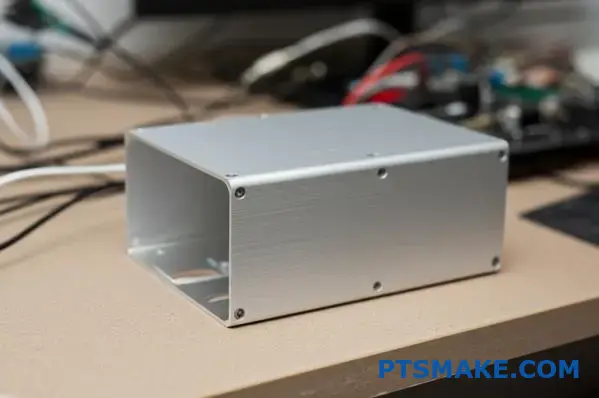
Precision Construction for Consistency and Reliability
Integrating speakers often involves matching pairs (for stereo) or multiple units (for surround sound). Consistent performance across all speakers is vital for a coherent soundfield.
The Role of Manufacturing Tolerances
CNC machining aluminum allows us to maintain incredibly tight dimensional tolerances, batch after batch. This means:
- Consistent Acoustic Volume: Every enclosure has virtually identical internal volume, crucial for predictable bass response and consistent tuning, especially in ported designs.
- Perfect Component Fit: Driver cutouts, port openings, and terminal cup recesses are machined precisely, ensuring airtight seals and proper driver alignment on every unit. This eliminates variations in performance caused by inconsistent assembly or sealing.
- Connector Alignment: Rear panel cutouts for binding posts or other connectors are precisely located, ensuring easy and reliable cable connections without straining terminals or requiring awkward angles.
Benefits for Multi-Speaker Setups
This consistency is paramount in home theater or professional studio environments where multiple speakers need to sound identical. Variations in enclosure construction (common with less precise methods or materials like wood which can vary) can lead to subtle but noticeable differences in sound between speakers that are supposed to be matched. The repeatability of CNC-machined aluminum speaker enclosures minimizes these variations, ensuring a more uniform and immersive listening experience. It also simplifies repairs or replacements down the line, as a replacement unit will match the originals precisely.
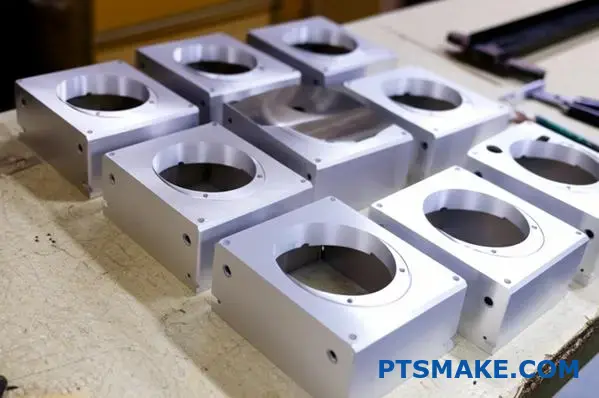
Ease of Integration: A Comparative Look
Let’s summarize how aluminum compares to other common materials specifically regarding integration factors:
| Feature | Aluminum (CNC Machined) | Wood (MDF) | Plastic (Molded) |
|---|---|---|---|
| Mounting Precision | Very High | Moderate | Moderate-High |
| Mounting Strength | Very High | Moderate (needs care) | Moderate |
| EMI/RFI Shielding | Excellent | Poor | Poor |
| Dimensional Consistency | Excellent | Fair-Good | Good (within mold) |
| Connector Fitment | Excellent | Good | Good |
| Overall Integration Ease | High | Moderate | Moderate |
While the initial focus might be on the acoustic benefits of an aluminum speaker enclosure, its advantages for integration are equally significant. The combination of versatile and robust mounting options, effective electromagnetic shielding, and the manufacturing consistency achieved through precision processes like CNC machining makes aluminum an ideal choice for incorporating high-performance speakers into complex, modern audio systems reliably and effectively. At PTSMAKE, ensuring this level of precision from prototype to production is fundamental to what we do, helping our clients achieve seamless integration for their demanding audio applications.
Custom Finishing Options for Brand Differentiation
Ever wonder how some audio brands make their products look so incredibly distinct, even iconic? Often, the secret lies beyond just the shape – it’s in the finish. The surface treatment of an aluminum speaker enclosure can transform it from a simple box into a statement piece.
Custom finishing options for an aluminum speaker enclosure, such as brushed textures, vibrant anodizing, versatile powder coating, and precise laser etching, are key tools. They allow brands to create unique visual identities, enhancing perceived value and ensuring products stand out in crowded markets.

When we talk about an aluminum speaker enclosure, its excellent acoustic properties and durability often dominate the conversation. But in today’s competitive market, functionality alone isn’t always enough. Aesthetics play a huge role in consumer choice and brand perception. The finish you choose for your aluminum enclosure is a powerful tool for communication, conveying quality, style, and brand identity before a single note is played. At PTSMAKE, we work with clients not just on the precision machining of the enclosure itself, but also on selecting and applying finishes that align perfectly with their brand vision and market goals. A well-chosen finish can elevate a product from merely functional to truly desirable.
The Power of the Finish: Beyond Protection
While finishes inherently provide a layer of protection against scratches, corrosion, and environmental factors, their role in branding is equally crucial. The tactile feel, the way light reflects off the surface, the specific color hue – these elements contribute significantly to the user’s overall experience and perception of quality. A premium finish suggests a premium product, reinforcing the value proposition of the high-fidelity audio equipment housed within the aluminum speaker enclosure. It’s about creating an emotional connection and ensuring the product visually represents the brand’s promise.
Exploring Key Finishing Techniques
Aluminum’s versatility extends beautifully to the variety of finishes it can accept. Each technique offers unique aesthetic possibilities and functional benefits, allowing for tailored brand expression.
Brushed Finishes: Subtle Elegance
A brushed finish creates a distinctive look with fine, parallel lines on the aluminum surface. This is typically achieved through mechanical means, using abrasive belts or brushes to create a unidirectional texture.
- Aesthetic Appeal: It imparts a subtle satin sheen that speaks of sophistication and technical precision. The texture helps diffuse reflections and can mask minor surface imperfections or fingerprints, maintaining a clean look over time.
- Branding Fit: Ideal for brands aiming for an understated, high-tech, or professional aesthetic. It conveys quality without being overly flashy. We often see this requested for high-end consumer electronics and pro-audio gear where visual subtlety is preferred.
Anodizing: Color and Durability Combined
Anodizing is an electrochemical process that thickens the natural oxide layer on the aluminum surface. This layer is extremely hard, durable, and integral to the metal itself.
- Key Benefits: It significantly improves corrosion resistance and abrasion resistance. Crucially for branding, the porous nature of the anodized layer before sealing allows it to absorb dyes, enabling a wide range of vibrant, translucent, or opaque colors. The color becomes part of the metal surface, resisting chipping or peeling.
- Customization: Brands can specify exact colors to match their visual identity, creating instantly recognizable products. Think of signature colors used across a product line. Common aluminum alloys like 6061 and 5052 anodize very well. At PTSMAKE, we can manage the process to ensure color consistency across production batches, which is vital for brand integrity.
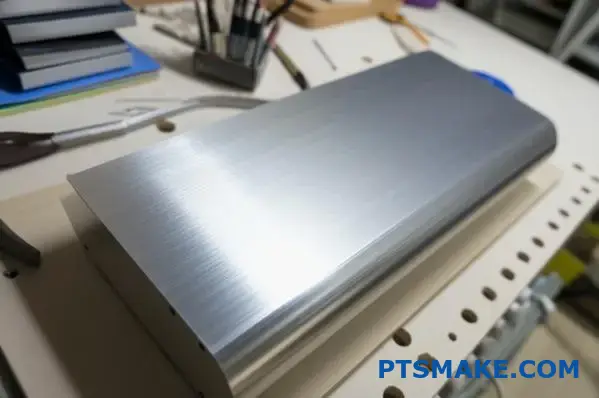
Powder Coating: A World of Hues and Textures
Powder coating involves applying a dry powder electrostatically to the aluminum surface, which is then cured under heat. This process melts and fuses the powder into a smooth, durable coating.
- Versatility: This is perhaps the most versatile finishing option in terms of appearance. An almost limitless spectrum of colors is available, along with various textures – gloss, matte, satin, metallic, wrinkled, hammered, and more. Opaque finishes are standard, completely covering the underlying metal.
- Durability & Branding: Properly applied powder coating is tough, offering excellent resistance to chipping, scratching, fading, and chemicals. This durability reinforces brand quality. The vast color and texture library allows brands to create truly unique and bold visual statements, perfectly matching packaging or other brand elements. Success hinges on meticulous surface preparation (the substrate8), a step we prioritize in our manufacturing workflow.
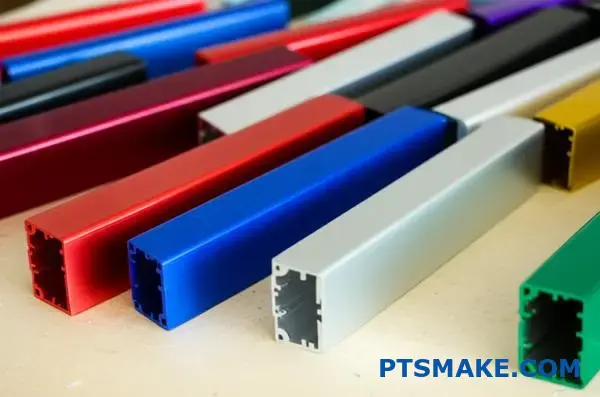
Laser Etching and Engraving: Precision Branding
Lasers can be used to selectively alter or remove material from the aluminum surface with incredible precision, creating permanent markings.
- Application: Ideal for adding logos, model numbers, serial numbers, intricate patterns, or other branding elements directly onto the finished enclosure. Laser etching typically marks the surface (often by changing its color or texture), while laser engraving removes material to create depth.
- Detail & Permanence: This method allows for very fine detail, far beyond what’s possible with traditional printing. The marks are permanent and resistant to wear, ensuring the branding lasts the lifetime of the product. It can be applied to raw, anodized, or powder-coated aluminum, often creating a contrasting mark for high visibility. This adds a final touch of customization and perceived value.
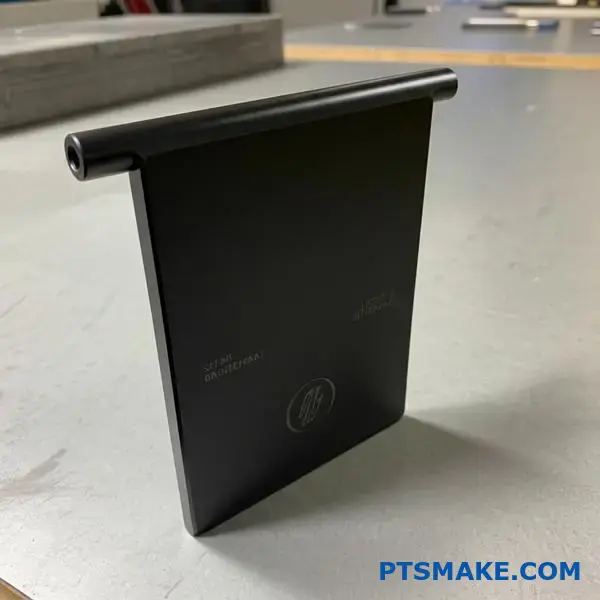
Combining Finishes for Unique Effects
For ultimate differentiation, finishes can sometimes be combined. Imagine a brushed aluminum speaker enclosure that is then anodized in a specific color, followed by laser etching of the brand logo through the anodized layer to reveal the brighter aluminum underneath. These multi-step processes require careful planning and execution but can result in truly unique and high-end aesthetics.
Choosing the Right Finish for Your Brand
Selecting the optimal finish involves considering several factors:
- Brand Identity: Does your brand convey luxury, ruggedness, minimalism, or playfulness? The finish should align.
- Target Audience: What aesthetic appeals to your intended customers?
- Product Use Environment: Will the speaker be indoors, outdoors, or in a demanding setting (like marine)? This impacts durability requirements.
- Desired Look & Feel: Specific colors, textures, and reflectivity needed?
- Budget: Different finishes have different associated costs, both in application and potentially in scrap rates if quality control is demanding.
Here’s a quick comparison to help guide the decision:
| Finishing Option | Key Aesthetic | Durability | Color Options | Branding Suitability | Relative Cost |
|---|---|---|---|---|---|
| Brushed | Satin, linear texture | Good | Metal’s natural | Understated, professional, high-tech | Low-Medium |
| Anodizing | Metallic sheen, translucent | Very Good-Exc. | Wide (depends) | Color matching, durable branding | Medium |
| Powder Coating | Opaque, various textures | Excellent | Vast | Bold colors, specific textures, rugged | Medium-High |
| Laser Etching | Precise contrast marking | Excellent (Mark) | N/A (Contrast) | Logos, serial numbers, fine details | Low (per mark) |
Working with an experienced manufacturing partner like PTSMAKE is invaluable here. We can provide samples, advise on the suitability of different finishes for specific aluminum alloys, and ensure the chosen finish is applied with the precision and quality control necessary to meet your brand’s standards. Ultimately, the finish on your aluminum speaker enclosure is a silent ambassador for your brand – choose it wisely to make the right impression.
Understanding this term helps appreciate how enclosure materials affect vibration control and sound clarity. ↩
Explore how this material property effectively turns unwanted vibrations into harmless heat. ↩
This is a reference point on an engineering drawing used to ensure consistent measurements. ↩
Understand this electrochemical process to avoid corrosion when using different metals together in marine environments. ↩
This term describes how quickly a system reacts to sudden changes in the input signal. ↩
Learn how TCO helps evaluate long-term value beyond just the initial purchase price. ↩
Discover how this principle shields electronics from unwanted interference. ↩
Knowing the base material’s condition is key for optimal finish adhesion and longevity. ↩


